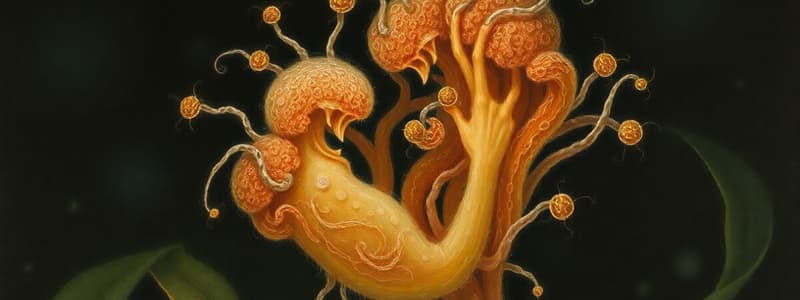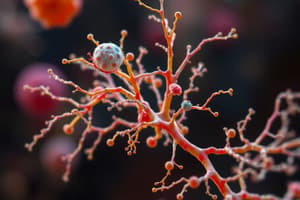Podcast
Questions and Answers
Under normal circumstances, where is a fetus located that is free of microbes?
Under normal circumstances, where is a fetus located that is free of microbes?
- In the intestine
- In utero (correct)
- In the bloodstream
- On the skin
What is the term for a close relationship between two different species of organisms in a community?
What is the term for a close relationship between two different species of organisms in a community?
- Predation
- Antagonism
- Symbiosis (correct)
- Competition
Which type of symbiotic relationship benefits both organisms involved?
Which type of symbiotic relationship benefits both organisms involved?
- Amensalism
- Parasitism
- Commensalism
- Mutualism (correct)
Which type of symbiotic relationship benefits one organism while neither harming nor helping the other?
Which type of symbiotic relationship benefits one organism while neither harming nor helping the other?
What type of symbiotic relationship benefits one organism and harms the other?
What type of symbiotic relationship benefits one organism and harms the other?
What term describes normal flora that are present for a short time before disappearing?
What term describes normal flora that are present for a short time before disappearing?
What is the usual effect of normal flora in a healthy person?
What is the usual effect of normal flora in a healthy person?
When can normal flora become opportunistic pathogens?
When can normal flora become opportunistic pathogens?
What is a portal of entry?
What is a portal of entry?
Which of these is a portal of entry for pathogens?
Which of these is a portal of entry for pathogens?
What is virulence?
What is virulence?
Pili and cell membrane proteins are involved in what virulence factor?
Pili and cell membrane proteins are involved in what virulence factor?
What virulence factor involves disrupting the host cell membrane?
What virulence factor involves disrupting the host cell membrane?
What is toxigenesis?
What is toxigenesis?
Where do bacterial toxins act?
Where do bacterial toxins act?
Which of the following is a characteristic of endotoxins?
Which of the following is a characteristic of endotoxins?
What is the study of the cause of disease called?
What is the study of the cause of disease called?
An infection confined to a specific tissue is called what?
An infection confined to a specific tissue is called what?
What is the term for the presence of bacteria in the blood?
What is the term for the presence of bacteria in the blood?
What is the time from initial contact with an infectious agent to the appearance of first symptoms called?
What is the time from initial contact with an infectious agent to the appearance of first symptoms called?
What is the recovery period of an infection called?
What is the recovery period of an infection called?
What kind of infection appears rapidly with severe symptoms and vanishes quickly?
What kind of infection appears rapidly with severe symptoms and vanishes quickly?
What is the study of the distribution and cause of disease in populations called?
What is the study of the distribution and cause of disease in populations called?
What does morbidity refer to?
What does morbidity refer to?
What is the number of new cases in a given population within a specified time period called?
What is the number of new cases in a given population within a specified time period called?
What is the term for a disease that is repeatedly present in a given population or geographical area?
What is the term for a disease that is repeatedly present in a given population or geographical area?
What term is used for sites where pathogens are maintained and become a source of infection?
What term is used for sites where pathogens are maintained and become a source of infection?
What are pathogens that normally infect animals but can affect humans called?
What are pathogens that normally infect animals but can affect humans called?
What is transmission via respiratory droplets considered?
What is transmission via respiratory droplets considered?
What is the mode of transmission involving pathogens transmitted by a nonliving object called?
What is the mode of transmission involving pathogens transmitted by a nonliving object called?
Transmission of an infectious agent through untreated sewage is what kind of transmission?
Transmission of an infectious agent through untreated sewage is what kind of transmission?
What kind of transmission involves animals, especially arthropods?
What kind of transmission involves animals, especially arthropods?
Healthcare Associated Infections are also known as what?
Healthcare Associated Infections are also known as what?
What type of Healthcare Associated Infections are caused by pathogens in the healthcare environment, shed by sick people?
What type of Healthcare Associated Infections are caused by pathogens in the healthcare environment, shed by sick people?
What type of Healthcare Associated Infections are caused by the use of medical procedures?
What type of Healthcare Associated Infections are caused by the use of medical procedures?
Flashcards
Symbiosis
Symbiosis
A close relationship between two different species of organisms in a community.
Mutualism
Mutualism
Both organisms benefit from the interaction; example E. coli in the human GI tract.
Commensalism
Commensalism
One organism benefits, the other is neither harmed nor helped; example some mycobacteria in the ear.
Parasitism
Parasitism
Signup and view all the flashcards
Amensalism
Amensalism
Signup and view all the flashcards
Resident Flora
Resident Flora
Signup and view all the flashcards
Transient Flora
Transient Flora
Signup and view all the flashcards
Portal of Entry
Portal of Entry
Signup and view all the flashcards
Exogenous
Exogenous
Signup and view all the flashcards
Endogenous
Endogenous
Signup and view all the flashcards
Virulence
Virulence
Signup and view all the flashcards
Adhesion
Adhesion
Signup and view all the flashcards
Invasion
Invasion
Signup and view all the flashcards
Toxigenesis
Toxigenesis
Signup and view all the flashcards
Endotoxin
Endotoxin
Signup and view all the flashcards
Exotoxin
Exotoxin
Signup and view all the flashcards
Portal of Exit
Portal of Exit
Signup and view all the flashcards
Etiology
Etiology
Signup and view all the flashcards
Local Infection
Local Infection
Signup and view all the flashcards
Focal Infection
Focal Infection
Signup and view all the flashcards
Systemic Infection
Systemic Infection
Signup and view all the flashcards
Bacteremia
Bacteremia
Signup and view all the flashcards
Septicemia
Septicemia
Signup and view all the flashcards
Toxemia
Toxemia
Signup and view all the flashcards
Viremia
Viremia
Signup and view all the flashcards
Incubation Period
Incubation Period
Signup and view all the flashcards
Prodromal Stage
Prodromal Stage
Signup and view all the flashcards
Convalescence
Convalescence
Signup and view all the flashcards
Mixed Infection
Mixed Infection
Signup and view all the flashcards
Acute Infection
Acute Infection
Signup and view all the flashcards
Chronic Infection
Chronic Infection
Signup and view all the flashcards
Primary Infection
Primary Infection
Signup and view all the flashcards
Secondary Infection
Secondary Infection
Signup and view all the flashcards
Epidemiology
Epidemiology
Signup and view all the flashcards
Morbidity
Morbidity
Signup and view all the flashcards
Mortality
Mortality
Signup and view all the flashcards
Incidence
Incidence
Signup and view all the flashcards
Prevalence
Prevalence
Signup and view all the flashcards
Endemic Disease
Endemic Disease
Signup and view all the flashcards
Sporadic Disease
Sporadic Disease
Signup and view all the flashcards
Epidemic Disease
Epidemic Disease
Signup and view all the flashcards
Study Notes
- A fetus in utero is normally free of microbes.
- During birth, a newborn is exposed to microbes, initiating the colonization of the infant's intestine.
Symbiosis
- Symbiosis describes the close relationship between different species within a community.
- Mutualism: Both organisms benefit in this interaction, for example, E. coli in the human GI tract.
- Commensalism: One organism benefits, while the other is unaffected; for example, some mycobacteria inhabiting the ear, living on secretions and dead cells.
- Parasitism: One organism benefits, while the other is harmed; for example, tuberculosis, helminths, and protozoa.
- Amensalism: One organism inhibits the growth/survival of another without being affected itself; for example, penicillium.
Normal Flora (Microbiota)
- Resident flora: Normal flora present throughout a person's life, for example, S. epidermidis and E. coli.
- Transient flora: Microbes that remain for hours, days, or months before disappearing, e.g., Bacillus Laterosporus.
- Normal flora is typically protective and doesn't cause disease in its normal habitat in healthy individuals.
- When balance is disrupted, normal flora can become opportunistic pathogens.
Portal of Entry
- Exogenous: Pathogens enter from the outside environment
- Endogenous: Pathogens arise from within the body
- Most pathogens have a preferred portal of entry.
- If a pathogen enters the "wrong" portal, infection may not occur.
- Some infectious agents can enter through multiple portals, such as Streptococcus and Staphylococcus.
Portals of Entry
- Skin
- Mucous membranes
- Placenta: Some microbes can cross the placenta, potentially causing spontaneous abortions, birth defects, or premature births, for example, HIV, Rubivirus, Cytomegalovirus, Parvovirus B-19, Treponema pallidum, Listeria monocytogenes, Toxoplasma gondii.
Virulence
- Virulence is the degree of pathogenicity or disease-provoking power of a specific microbe.
- Adhesion: The initial step of infection, facilitated by pili and cell membrane proteins.
- Colonization: Occurs in tissues in contact with the external environment, such as the urogenital, digestive, and respiratory tracts, and the conjunctiva.
- Invasion: Disruption of host cell membranes and barriers by invasins.
- Evasion of Host Defense: Mechanisms to avoid phagocytes, inhibit engulfment, survive inside phagocytes, or produce substances that harm phagocytes.
Toxins
- Toxins are a major virulence factor
- Toxigenesis is the ability of an organism to produce toxins.
- Bacterial toxins can act on sites remote from the original infection site.
Endotoxin
- Lipopolysaccharides found in the gram-negative cell wall.
- Released during cell lysis, whether by host defense or antibiotics.
- Less potent and less specific than exotoxins.
- Heat-stable but can be affected by certain oxidizing agents like peroxide.
- Example: Shiga toxin.
Exotoxins
- Proteins released by bacteria during the exponential growth phase.
- More potent and specific than endotoxins.
- Heat-labile and can be affected by acids and proteolytic enzymes.
- Examples include enterotoxins, neurotoxins, leukocidins, and hemolysins, named according to their target tissue.
Portal of Exit
- The site where a pathogen leaves an infected person.
- Often the same as the portal of entry.
- Pathogens can also exit through defecation, blood, nasal secretions, saliva, sputum, respiratory droplets, tears, and earwax.
Etiology of Infectious Disease
- The study of the cause of disease.
Patterns of Infection
- Local infections: The organism remains confined to a specific tissue.
- Focal infections: The pathogen spreads from a local infection to other tissues.
- Systemic infections: Infection spreads to multiple sites and tissues, usually through the circulatory system.
- Bacteremia: Presence of bacteria in the blood.
- Septicemia: Systemic infection caused by the multiplication of pathogens in the blood.
- Toxemia: Presence of toxins in the blood.
- Viremia: Presence of viruses in the blood.
- Incubation period: Time from initial contact with the infectious agent to the appearance of first symptoms.
- Prodromal stage: Earliest, nonspecific symptoms like discomfort, weakness, headache, muscle pain, upset stomach.
- Convalescence: Recovery period.
- Rehabilitation: Maximizing function of diseased tissue.
- Mixed infection: Several infectious agents concurrently establish themselves at the same site.
- Acute infection: Rapid onset with severe symptoms, vanishes quickly.
- Chronic infection: Less severe symptoms but persist for a long period.
- Primary infection: The initial infection.
- Secondary infection: Follows a primary infection.
- Subclinical infection: No apparent symptoms, can last a long time.
Epidemiology and Public Health
- Epidemiology: the study of the distribution and causes of disease in populations.
- Examines the number of people affected, location, and disease outcomes (recovery, death, disability, etc.).
- CDC: Central source of epidemiological information.
- Releases data on morbidity, mortality, and the incidence of specific notifiable diseases.
- Morbidity: Number of patients with a disease within a group.
- Mortality: Number of deaths resulting from a particular disease.
- Incidence: Number of new cases in a given population within a specified time.
- Prevalence: Number of new and old cases in a specific population within a specified time.
Disease Categories
- Endemic disease: Repeatedly present in a given population or geographic area, such as the common cold.
- Sporadic disease: Breaks out only occasionally, for example, typhoid fever in the U.S.
- Epidemic disease: Occurs more frequently than usual in a population, such as influenza.
- Pandemic disease: A worldwide epidemic, such as AIDS and the 1918 influenza.
Reservoirs
- Sites where pathogens are maintained and become a source of infection.
- Animal reservoir: Pathogens that infect animals and can affect humans (zoonoses).
- Human carriers: Individuals who are symptom-free.
- Nonliving reservoirs: Include soil, water, food, fomites.
Modes of Transmission
-
Contact Transmission
- Direct Physical Contact: Between hosts without an intermediate object.
- Person-to-person contact like touching, kissing, and sexual intercourse.
- Examples include respiratory tract infections, staphylococcal infections, measles, scarlet fever, and STDs.
- Indirect Contact: Pathogen transmitted by a fomite (nonliving object) like tissues, handkerchiefs, towels, bedding, toys, clothes, diapers, eating utensils, drinking cups, medical equipment.
- Droplet Transmission: Infectious agents are transmitted via respiratory droplets that travel less than a meter.
- Airborne Transmission: Organisms travel more than 1 meter.
- Direct Physical Contact: Between hosts without an intermediate object.
-
Water-borne & Food-borne Transmission
- Through untreated or poorly treated sewage and undercooked or unsanitarily prepared foods.
- Causes gastrointestinal diseases like giardiasis, amebic dysentery, cholera, shigellosis, and Hepatitis A & E.
-
Bodily Fluid Transmission
- Blood, urine, saliva, and other bodily fluids.
-
Vector Transmission
- Animals, especially arthropods.
- Biological Vectors: Biting insects, like mosquitoes, ticks, lice, fleas, and blood-sucking flies.
- Mechanical Vectors: Passively carry agents on their feet or other body parts.
- Animals, especially arthropods.
Healthcare Associated (Nosocomial) Infections
- Acquired in a hospital or similar setting, among the top 10 leading causes of death in the U.S.
- Annually, 99,000 patients die from nosocomial infections in the U.S.
- Exogenous HAIs: Caused by pathogens in the healthcare environment shed by sick people.
- Endogenous HAIs: Caused by microbes in the patient's normal flora.
- Iatrogenic HAIs: Caused by medical procedures like catheter use, invasive diagnostics, and surgery.
Studying That Suits You
Use AI to generate personalized quizzes and flashcards to suit your learning preferences.



